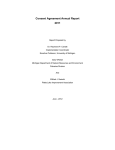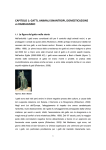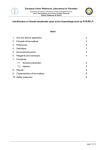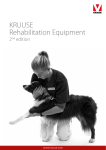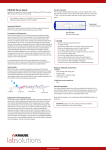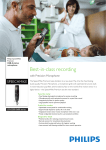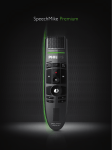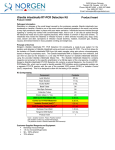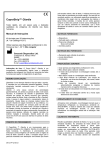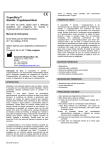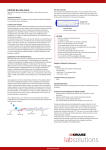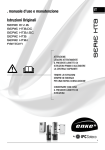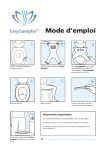Download labsolutions
Transcript
KRUUSE Giardia Quick The Test Cassette Rapid test for detection of Giardia duodenalis antigen in faeces of dogs and cats. Instruction Manual The test strip is located behind the plastic cover. The sample well is located on the right side and the reaction field in the middle of the test cassette. The “C” and “T” next to the reaction field show the test region and the control region. KRUUSE Giardia Quick is used for the rapid and reliable detection of Giardia antigen in faeces of dogs and cats. Sample well for sample material Giardia Duodenalis Towards the end of the 20th Century, Giardia weas identified as a pathogenic protozoa. Giardia is a microscopic intestinal parasite. Giardia duodenalis (also known as Giardia intestinalis, Lamblia intestinalis or Giardia lamblia) belongs to the group of flagellates with two nuclei. They can colonize and infect various mammals and birds worldwide. The intestinal parasites have a pear-shaped form with two typical nuclei, that appear as a a pair of eyes. To move around Giardia use their flagella. With the help of an abdominal adhesive disc, the diarrheal pathogens are capable of adhering to the intestinal wall of the host, i.e. they do not penetrate into the tissue. On the surface of the intestinal mucosa, they then multiply millionfold. Giardia are among the most widespread intestinal parasite worldwide. Giardia have a relatively high survival ability against environmental influences, and they are extremely resistant, even to disinfectants. To infect other creatures (i. a. dogs, cats and humans), Giardia encyst in the intestine and pass in the faeces. Cysts can survive in the environment for days, even weeks until they are ingested by a new host, for example through contaminated water or food. The infectious parasites remain infectious in moist soil for up to seven weeks and in cool water (4 ° C) for up to three months. Under optimal conditions they may remain viable for several months. Giardiasis is usually is a latent disorder of the digestive system. Clinically manifested giardiasis occurs mainly in young animals aged between 6 and 12 months. Older animals seem to have developed some immunity against an infection with Giardia. A carbohydrate rich diet and gastrointestinal disorders are among the predisposing factors for the onset of a clinically manifested Giardiasis. The duration of the disease varies from one week to several months, if the animal is not treated. Giardiasis is diagnosed by the detection of mobile Giardiatrophozoites in fresh faeces. Because the excretion of Giardia cysts and trophozoites often is intermittent, repeated testing is recommended. At least three different faecal examinations over a period of approximately seven to ten days should be conducted where all results are negative before a potential Giardiasis can be excluded. Attention: For various reasons, it may be difficult to treat Giardiasis. Giardia can be resistant to common drugs. In addition, other diseases or immunosuppression of the patient can make elimination of the pathogen difficult. Secondary infection can easily occur because the cysts are very resistant and only very few cysts are necessary to infect animals or humans. To eliminate the very resistant Giardia cysts, a thorough disinfection of the environment is necessary. Test Principle KRUUSE Giardia Quick is a diagnostic method for detection of Giardia duodenalis antigen in faeces of dogs and cats. KRUUSE Giardia Quick is an immunochromatographic assay with specific monoclonal antibodies against cell wall proteins of Giardia duodenalis trophozoites and cysts, which also is used as a capture antibody. Explanation of the Testing Process The test strips consist of different components. When the specimen is added into the sample well, it will be absorbed by the absorbent pad of the test strip. The fluid mixes with the gold labelled antibodies in the conjugate pad. Due to capillary action the fluid starts to move up the test strip, passing the test line region followed by the control line region. The control line should always appear if the test is functioning correctly. If the specimen contains the specific pathogen for the test strip, a line will appear in the test line region. The test line forms by building a sandwich between the gold labelled antibodies from the conjugate pad, the antigen from the specimen and the immobilized antibody in the test line region. If no pathogen is present in the specimen, the gold labelled antibodies cannot bind to the immobilized antibodies in the test line region and therefore no test line appears; the test result is negative. Reaction field test and control region CAUTION · · · · · · · · · · · · Only for veterinary and professional use For single use only Use the test cassette within 10 minutes of opening the pouch Please use the appropriate amount of sample material Do not apply sample solution to the reaction field Avoid cross reactions by using a new sample tube for each sample Do not touch the reaction field Use only the original buffer provided in the kit Faeces could be infectious. Be careful with waste disposal Do not use the test after the expiry date printed on the pouch Do not use the test if the packaging is damaged Consider the test results as invalid after the indicated testing time Reagents, Materials, Innstruments I. Contents • 5 test cassettes with drying pad • 5 cotton swabs • 5 test tubes with 1 ml dilution buffer • 1 instruction manual II. Additional necessary equipment •Timer Application The test has been developed for the examination of faeces of dogs and cats. Repeated testing at different days increases the sensitivity of the test because the cysts are excreted irregularly with the faeces. With only one fecal examination, it may occur that no cysts are excreted and thus the test indicates a negative result, despite a possible Giardia infection. It is recommended to perform the test at three different times to achieve the specified sensitivity. Fresh faecal samples should be tested for optimal detection of Giardia. Sample Preparation The sample should be tested as quickly as possible after collection. If this is not possible, the specimen can be stored at temperatures between 2°C and 8°C for a period of up to 24 hours. If it is necessary to store the specimen longer, it must be kept at a temperature below -20°C. Ensure that the sample is not contaminated with formaldehyde solutions or derivatives. ATTENTION: Samples and other materials should be handled as infectious materials. Use care when handling. labsolutions www.kruuse.com Sampling Test Evaluation Use the cotton swab to take a significant amount of faeces. It is sufficient when the tip of the swab is covered with faeces. The results of the test can be read within 5-10 minutes of applying the sample fluid. Practical Tip: Faeces of cats usually are more grainy than dog faeces. If you cannot pick up sufficient faecal material with the swab, moisten the tip of the cotton first in the buffer fluid and then pick up the faecal material. Repeat the process until the liquid significantly changes colour. Positive Result The test is positive when the control line (C) and the test line (T) appear in the reaction field. Here Giardia was detected. Even when a weakly defined test line appears, the test result is positive. The red colour in the test region will vary depending on the concentration of pathogens present in the sample. Negative Result The test is negative when only the control line appears. No defined test line is visible. The test on the left displays a clear negative test result, no Giardia antigen was detected. After the sampling continue with the test procedure. 1. 2. IMPORTANT: As cyst excretion does not occur with every passing of faeces, a negative test result does not necessarily exclude a persistent Giardia duodenalis infection. The test should be carried out once more with a pooled faecal sample after approximately one week. Invalid Result 3. If no control line appears after the test is performed, the test is invalid. In this case, it is likely that the test was not correctly carried out or the test may have passed the expiry. If this occurs, a new test must be conducted. 4. ATTENTION: The results must be read within 10 minutes of starting the test. The test and the result are considered invalid after that period. Storage Test Procedure KRUUSE Giardia Quick must be stored at room temperature (2°C to 30°C). All material used to perform the test should have room temperature 1. Open the test tube containing the dilution buffer. Take the cotton swab and put the tip of the swab with the faecal sample into the test tube containing the dilution buffer. Stir up the fluid with the swab. The fluid colour should change into slight yellow/brown. 2. Tightly close the test tube with the buffer. The dilution buffer in the tube will treat and conserve the sample. Shake the test tube well for a few seconds. Disposal A safe disposal is recommended. Faecal samples and test cassettes should be collected in a sealable plastic bag. Test Performance Characteristics Sensitivity and Specificity with faeces KRUUSE Giardia Quick Enzyme-linked Immunosorbent Assay 3. Take the test tube and break off the pin. 4. Invert the test tube and place 3 drops of the sample fluid into the sample well. Giardia duodenalis Sensitivity Specificity 98,15 % 96,13 % References Remark: If the liquid is not running well up the strip after 45 seconds, add an additional drop of buffer material into the sample well 1. Krankheiten der Katze (Hrsg.: M. Chr. Horzinek / Vera Schmidt / Hans Lutz) Enke, 4. Auflage, 2005, S. 199 – 200 2. Innere Medizin der Kleintiere (von Richard W. Nelson – C. Guillermo Couto) Elsevier, 2006, S. 471 Symbols Used Only for one use ∑ labsolutions Content +30°C Storage temperature +4°C Lot number www.kruuse.com Read user instruction carefully Expiry date


